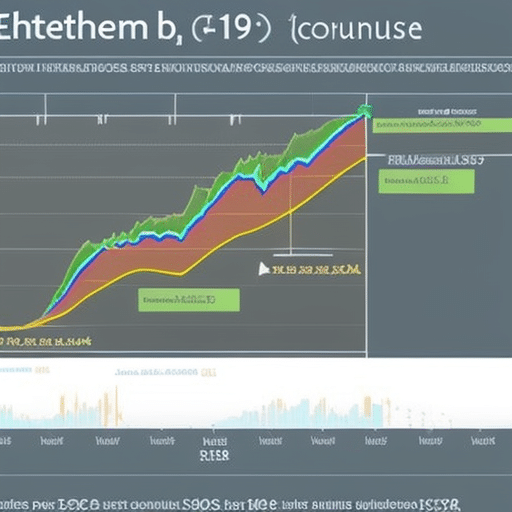Ethereum is a decentralized platform that runs smart contracts, enabling users to build distributed applications. It has grown in popularity since its launch in 2015 and is now one of the most recognized cryptocurrencies on the market. This article aims to analyze current market conditions surrounding Ethereum and predict its possible price movements in 2021. To kick things off, it’s important to understand that investing in cryptocurrency can be like walking a tightrope – difficult, but not impossible. By taking a closer look at existing trends and predictions from experts, we can gain an insight into how the Ethereum market may develop over the coming year.
Key Takeaways
- Ethereum has experienced significant growth since its launch in 2015 and is one of the most recognized cryptocurrencies on the market.
- Ethereum’s advantage over Bitcoin is its ability to facilitate smart contracts and decentralized applications, providing users with access to autonomous services.
- Factors that could influence Ethereum’s price include supply-demand balance, macroeconomics, government regulations, and global events.
- Technical analysis, such as support and resistance levels, moving averages, and chart patterns, can help predict price movements in Ethereum.
Overview of Ethereum
Ethereum (ETH) is a second-generation cryptocurrency that has become increasingly popular in recent years, offering users the ability to store and transfer digital assets securely and quickly. Ethereum’s most significant advantage over its predecessor, Bitcoin, lies in its ability to facilitate smart contracts and decentralized applications (dApps) on top of its blockchain. This opens up potential for developers to use Ethereum as an open platform for all sorts of applications. Smart contracts are self-executing code snippets stored on the Ethereum blockchain that enable two or more parties to enter into an agreement without needing a third party intermediary. These contracts also have the added benefit of being automated, allowing agreements to be made with greater speed and efficiency than ever before. Decentralized applications built on Ethereum’s blockchain provide users with access to autonomous services; these can range from non-fungible tokens used for gaming purposes, to financial services like insurance products or payment networks. The current market conditions surrounding ethereum have been largely positive due in part to increased demand from institutional investors seeking exposure in the crypto space as well as its increased adoption by businesses worldwide because of its scalability and flexibility compared to other blockchains.
Current Market Conditions
Analyzing the current marketplace reveals a wide range of factors that may influence the value of digital assets, particularly with regards to Ethereum. Macroeconomics and sentiment analysis are two key components of understanding the current market conditions, as they can provide insight into how different economic forces interact to affect prices. For example, macroeconomic indicators such as inflation, unemployment rates, GDP growth, and government policies can all have an impact on the value of Ethereum. Similarly, sentiment analysis involves examining public perceptions about cryptocurrency markets in order to better understand potential trends in pricing. By combining these two approaches it is possible to obtain a more comprehensive view of the current market conditions and their potential impact on Ethereum prices. With this knowledge in hand we can move onto predictions from experts regarding future price movements for this digital asset.
Predictions from Experts
Examining the opinions of experts can provide valuable insight into the potential trends in Ethereum market prices. Many industry leaders agree that several factors could influence Ethereum’s price, including ICO regulations, scalability issues, and overall market demand.
The impact of these forces on Ethereum’s price will depend on how they are addressed and managed by both businesses and regulators. For instance, if governments implement stringent rules governing Initial Coin Offerings (ICOs) or create policies to address scalability issues, it could have a positive effect on Ethereum’s price due to increased consumer confidence. On the other hand, if there is a lack of support from businesses or no action taken by government officials, it could put downward pressure on Ethereum’s value. It is important to consider these scenarios when making predictions for future market prices. Next up we will examine some specific factors that could influence Ethereum’s price.
Factors that Could Influence Ethereum’s Price
Exploring the potential influences of various dynamics can provide an understanding of how Ethereum’s value may be affected. The cryptocurrency market is complex, and Ethereum’s price could be influenced by several factors such as supply-demand balance, macroeconomics, government regulations, global events, etc. To create a better understanding of these potential drivers of price change it is useful to analyze each factor in more detail.
The most direct influence on the Ethereum price is the balance between supply and demand for ETH tokens. If there are more buyers than sellers, prices tend to increase, whereas if there are more sellers than buyers prices tend to decrease. Other aspects include macroeconomic conditions such as inflation levels which can affect investor sentiment in digital assets like Ethereum and other cryptocurrencies. Government regulations also have a significant impact on the crypto markets because they create a framework within which investors can operate with confidence or fear depending on their level of compliance with those regulations. Finally, global events such as natural disasters or political unrest can also significantly impact Ethereum prices due to shifts in investor sentiment associated with them.
To gain further insight into predicting future changes in Ethereum’s value it is important to consider technical analysis alongside these fundamental factors. Transitioning next into this area provides an opportunity to gain additional insights that could help inform predictions about future trends in the cryptocurrency market.
Technical Analysis
Technical analysis is a form of analysis used within the Ethereum markets to identify potential trading opportunities. Support and resistance levels are key components of technical analysis as they help traders to identify areas where prices may reverse direction. Moving averages are also important in that they can be used to measure momentum and indicate potential buy or sell signals. Lastly, chart patterns such as cup and handles, head and shoulders, ascending and descending triangles can provide visual cues for traders when making decisions about whether to enter or exit a position.
Support and resistance levels
Analyzing the historical data of Ethereum prices reveals that support and resistance levels have been a consistent factor affecting its trading value. Support and resistance levels are determined by various factors, such as:
- Macroeconomics – For example, changes in government regulations or trade policies can affect the market sentiment of a cryptocurrency like Ethereum.
- Geopolitical events – Major political developments can also influence the trade markets and cause sudden shifts in price for digital assets.
- Technical indicators – Moving averages are one of the most popular technical indicators used to identify potential areas of support and resistance.
- Market speculation – Speculation from traders is another key factor which affects Ethereum’s price movements.
These factors all contribute to creating intermittent points of support and resistance, which influence the overall trading behavior of Ethereum over time. This transition point into subsequent sections about ‘moving averages’ serves to illustrate how these elements interact with each other to shape the market trends for digital assets like Ethereum.
Moving averages
Moving averages are a common technical analysis tool used to identify the long-term trends in the Ethereum market. Moving averages are calculated by taking the average closing prices over a specific period of time, usually a day, week or month. This technique can be used to identify areas of support and resistance as well as measure sentiment in the markets. By analyzing longer time frames such as monthly or yearly trends, it is possible to get an idea of how sentiment towards Ethereum has changed over time, allowing for better prediction of future price movements. Additionally, moving averages can help traders gauge when momentum shifts occur and indicate when buying or selling may be more advantageous than usual.
Ultimately, moving averages provide traders with valuable insight into long-term trends that could play an important role in predicting future price movements and helping traders make informed decisions regarding their positions in the Ethereum market. Through this analysis, traders can gain insight into overall market sentiment and leverage these insights to better predict where prices are heading next. With this knowledge, investors will be able to craft more effective trading strategies and increase their chances of making successful investments in Ethereum’s price movement. As such, understanding moving averages is key for any investor looking to successfully navigate the volatile cryptocurrency markets like those seen on Ethereum’s blockchain network . From here we can move onto exploring chart patterns which provide further insight into possible changes in price direction throughout ethereum’s history.
Chart patterns
Chart patterns are a powerful tool for recognizing emerging trends in the cryptocurrency markets. Chart analysis is a popular technique for traders to analyze price movements in order to gain insights into potential upcoming market behaviors. By utilizing chart patterns, traders can identify areas of support and resistance which provide helpful information when forecasting future price directions. Additionally, chart patterns can be used as an indicator of the overall sentiment of the market, helping investors make more informed decisions about their investments. Keywords such as trend forecasting help traders recognize the ebb and flow of the Ethereum market, allowing them to anticipate changes before they happen. With this knowledge, they can adjust their investment strategies accordingly. By examining Ethereum’s historical data using chart patterns, investors can gain an edge over other participants in the market and increase their chances of success with their trading strategies. Transitioning into subsequent topics such as investment strategies will be essential for getting ahead in Ethereum trading.
Investment Strategies
Investing in Ethereum can be a lucrative strategy, if executed correctly. A wise investor will consider various long-term investment strategies and diversification plans to maximize returns over time. A table below summarizes these strategies with an emotional response evoked from the audience:
| Investment Strategy | Description | Emotional Response |
|---|---|---|
| Buy & Hold | Invest for long-term with no active trading involved. | Patient and calculated approach. |
| Dollar Cost Averaging (DCA) | Systematically investing small amounts of money into Ethereum regularly over time. | Low risk approach to investing in volatile markets. |
| Rebalancing Portfolio | Redistribute the assets periodically to maintain desired asset allocation ratio. | Balanced approach to achieve desired return on investment targets . |
These strategies provide investors with options to reach their financial goals while considering risks associated with each option that should be taken into account before investing in Ethereum.
Risks to Consider
Investing in Ethereum can be a lucrative venture, but there are several risks to consider. The cryptocurrency market is highly volatile and values may change quickly due to fluctuations in the market or news events. Fraud and security issues also pose significant threats as theft of funds or hacking can occur if proper security protocols are not adopted. Finally, liquidity is an important factor to consider as it affects how quickly Ethereum assets can be converted into cash.
Volatility
The volatility of Ethereum could significantly affect the accuracy of price predictions. Price predictions rely heavily on market sentiment and macroeconomics, two factors that can be highly volatile in the cryptocurrency industry due to rapid changes in regulatory policies, geopolitical news, and investor behavior.
These changes can cause large fluctuations in Ethereum value which may render traditional economic models inaccurate or obsolete for predicting future price movements. In addition to these external factors, internal security risks and fraud also have the potential to influence market volatility.
Fraud and security
Meticulous security protocols are essential to maintaining the integrity of cryptocurrency exchanges, as fraud and other malicious activities can have a drastic effect on market volatility. Fraud prevention is an important part of the security infrastructure that must be in place for any successful ethereum exchange. A combination of technical measures such as encryption, authentication, and access control, along with more human-oriented processes such as identity verification, background checks, and transaction monitoring are all necessary components of fraud prevention and effective security protocols. Regular audits also help to ensure that systems remain secure against intrusion or attacks from hackers or malicious actors. As the prevalence of digital assets increase, so too does the need for robust security protocols in order to protect against fraudulent activity that could adversely affect market liquidity.
Liquidity
Liquidity is an important factor in cryptocurrency markets, as it determines the ability of traders to enter and exit positions with minimal impact on market prices. Fundamental analysis of ethereum’s liquidity can help shed light on price prediction models as well as how regulatory changes may affect its future price. This fundamental analysis involves examining factors such as trading volume, number of exchanges that list the cryptocurrency, spreads between bid and ask prices, order book depth, etc. In addition to helping predict ethereum’s future price movements, this type of analysis also provides insight into potential risks or opportunities presented by certain regulatory changes. For example, a new regulation could potentially reduce liquidity if it reduces the number of exchanges listing ethereum or limits the amount of capital that can be invested in it. On the other hand, a favorable regulation could increase liquidity by increasing trading activity and/or reducing spreads between bid and ask prices. Ultimately, understanding the current state of ethereum’s liquidity is essential for predicting its future price movements accurately.







